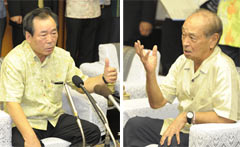Defense Minister says Henoko environmental impact report will be submitted to Okinawa Governor and Nago Mayor before the end of the year

On the morning of October 17, at the Okinawa Prefectural Office, on the matter of the relocation of Futenma Air Station, Defense Minister Yasuo Ichikawa indicated his intention to submit an environmental impact statement later this year to Governor Hirakazu Nakaima (right) ahead of the reclamation of the coastal area of Henoko in Nago City.
October 18, 2011 Ryukyu Shimpo
On October 17, Defense Minister Yasuo Ichikawa met with Okinawa Governor Hirokazu Nakaima at the Okinawa Prefectural Office, and then with Nago City Mayor Susumu Inamine at Nago City Hall. At these meetings, he explained that before the end of this year he intends to submit a written evaluation to them on the environmental impact of the reclamation of the coastal area of Henoko, Nago City, which has been decided upon as the site for relocation of the United States Marine Corps Air Station (USMCAS) Futenma. This is the first time that the central government has officially conveyed this to Okinawa Prefectural Government. The Governor responded by saying, “I have made political commitments on this matter,” and asked that the Futenma Air Station be relocated outside the prefecture.
Chief Cabinet Secretary Osamu Fujimura held a press conference in Tokyo that same day, at which he also made it clear that the government intends to submit the evaluation report later this year.
The submission of this report means that the environmental assessment procedure, which has effectively been in a stalemate for almost two years, may move forward, and so in terms of procedural requirements at least, the plan to relocate the facilities at Futenma to Henoko will move ahead. However, at this point in time, Governor Nakaima’s stance of wanting the Futenma Air Station to be relocated outside the prefecture is unchanged, so the outlook for genuine progress on the relocation plan is not good.
In his meeting with the governor, Defense Minister Ichikawa said, “In June, both [the United States and Japanese] governments confirmed the location and configuration of the replacement facility for Futenma Air Station that was decided in the Japan-U.S. agreement. We are now getting ready to submit the evaluation report [on the environmental impact of the relocation] before the end of this year.”
Governor Nakaima responded by saying, “The situation surrounding the Futenma issue has changed considerably in the two years since then [ie. Since the submission of the preparatory documents representing the previous step in the evaluation report]. What is happening about the [deployment of] the Osprey aircraft?” “I have political commitments that I must adhere to. People’s anger is still unresolved. Please do not forget that the blame for this situation can be attributed in part to your Democratic Party.” With this the governor again demanded the relocation of Futenma outside the prefecture.
At a press conference before his return to Tokyo, with regard to the plan to deploy MV-22 Osprey vertical takeoff and landing transport aircraft to Futenma Air Station, a matter that was not included in the preparatory environmental impact assessment statement issued by the government, Ichikawa said, “[The United States Government] has indicated its intention to deploy these aircraft next year. We will cover this in the evaluation report. I want to be able to explain this properly.” The government will evaluate the effect of possible changes in the model of aircraft to be deployed, and Ichikawa indicated that the intention is to complete the assessment of the impact of deploying Osprey aircraft this December.
«Terminology related to the Environmental Impact Statement.»
In the case of large construction projects, the business operator (the central government) is required by law to investigate, predict and evaluate the environmental impact of related business procedures and to submit a report on this to the relevant prefectural and city governments as the final stage in the process. The governor must then return a written statement of opinion within 90 days of having received the evaluation report from the business operator. The central government then makes amendments based on that written statement of opinion, and with this, the evaluation assessment is complete. The central government can then apply for approval from the governor for the construction landfill.
(English Translation by T&CT, Mark Ealey)
Previous Article:Futenma roar appeal dismissed by Supreme Court without issuing a flight ban
Next Article:Nago Mayor demands the withdrawal of the Henoko plan to Foreign Minister, who is driving it as the site for the Futenma relocation
[Similar Articles]
- Defense Minister intends to submit Henoko environmental impact report before the end of the year
- Relocation of Futenma Air Station:U.S. Defense Secretary urges Japan to move as soon as possible on application procedures for the Henoko landfill
- Okinawan governor submits opinion on the Futenma relocation plan, calling it “impossible”
- Okinawa Prefectural Board rejects Futenma relocation plan after reviewing Henoko environmental impact report
- The full text of the Henoko environmental impact report revealed
 Webcam(Kokusai Street)
Webcam(Kokusai Street)


